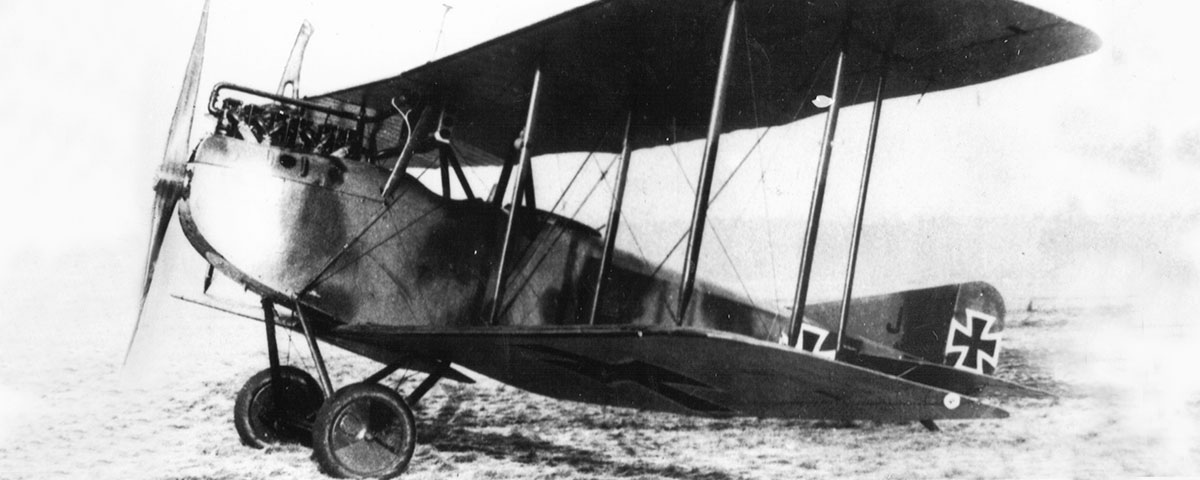The Germans beat the Russians in developing a ground-attack airplane—by an entire war.
During World War I, few combat assignments were as dangerous and as disliked by aircrews as ground-attack missions. Strafing was certainly terrifying to troops in the trenches, but it was no picnic for the airmen either. Flying low and slow over enemy positions, the flimsy wood-and-fabric biplanes used for ground attack early in the war were often targeted by small-arms fire, and the engines, fuel supply and crewmen were completely unprotected.
That state of affairs finally began to be addressed in 1917 by the Allgemeine Elektrizitäts-Gesellschaft (General Electricity Company), or AEG. Founded in 1883 to produce electrical machinery, AEG was known for, among other things, the invention of the hairdryer. In 1910 the firm branched out into aircraft, becoming a major supplier to the German army air service throughout WWI.
AEG’s first successful design, the C.IV reconnaissance plane of 1916, featured an airframe that, apart from wooden wing ribs, was made entirely of steel tubing. Powered by a 160-hp Mercedes D.III engine, the AEG C.IV had a short fuselage in proportion to its wingspan, which gave it an ungainly look, and its performance was not stellar. But it was sturdy and reliable enough for 170 C.IVs to reach the front in June 1917 and 40 to remain in active service during August 1918.
By 1917, most combat planes were being designed for reconnaissance, bombing or air-to-air combat, but the fall of that year saw many of those same aircraft adding ground attack to their repertoire. In September the Halberstadt CL.II made its debut specifically in that role. A relatively compact, lightweight two-seater, the Halberstadt—and its later stable mate, the Hannover CL.III—relied primarily on agility to dodge groundfire while it rained bullets and grenades on the enemy.
In an effort to address the hazards of ground-attack missions, AEG began developing an entirely new category of trench-strafer incorporating armor protection. From the outside AEG’s armored biplane appeared fairly conventional, but its airframe was essentially the same innovative welded steel tube structure featured in the C.IV. Over that framework, the entire forward fuselage, from the nose to the rear of the cockpit, was encased in armor plate, totaling 105.8 square feet in area and weighing 860 pounds. The 5.1mm-thick plates were sufficient protection against regular British .303-inch ammunition at a distance of 50 yards, but they proved unable to stop armor-piercing bullets within 500 yards.
Although the engine, crew and main fuel tank beneath the pilot’s seat were protected by armor, the aircraft was still vulnerable. A second gravity tank in the leading edge of the upper wing remained unprotected, and the radiator—beneath the upper wing, just above the pilot’s head—constituted an even more serious liability: One hit and the pilot would be doused with scalding water!
The armored AEG’s armament fit its mission. In addition to the usual flexible 7.92mm Parabellum machine gun in the rear cockpit, two fixed 7.92mm LMG 08/15 machine guns were installed inside the rear to fire downward at a 45-degree angle. The absence of fixed forward-firing guns made it clear that the new aircraft was not intended for aerial combat.
Designated the J.I, the armored biplane had a wingspan of 42 feet 6 inches and was 25 feet 7 inches long. Its fully loaded weight of 3,201 pounds was fairly substantial for its 6-cylinder 200-hp Benz B.IV. Not surprisingly, the prototype displayed poor lateral control, leading AEG to revise the C.IV wings to accommodate two ailerons linked by a strut, rather than a single set, in the J.Ia.
The Germans were sufficiently impressed with AEG’s effort that several other armored aircraft were developed, including the AEG J.II of 1918, whose primary refinements were aerodynamically balanced ailerons and enlarged tail surfaces. A total of 609 AEG J-type armored planes were built. Junkers also produced 227 of an even more structurally advanced all-metal armored sesquiplane, also designated J.I (or J4, the manufacturer’s designation).
Interest in the armored ground-attack aircraft lapsed after WWI, but revived just before a new world war began. The Allies and the Axis powers both developed such aircraft, the most famous being the Ilyushin Il-2 Shturmovik, built in larger numbers than any other warplane in history. The U.S. Air Force still maintains an aircraft of the type in its inventory today, the Fairchild Republic A-10 Thunderbolt II, as does Russia with its Sukhoi Su-25.
Originally published in the November 2014 issue of Aviation History. To subscribe, click here.





